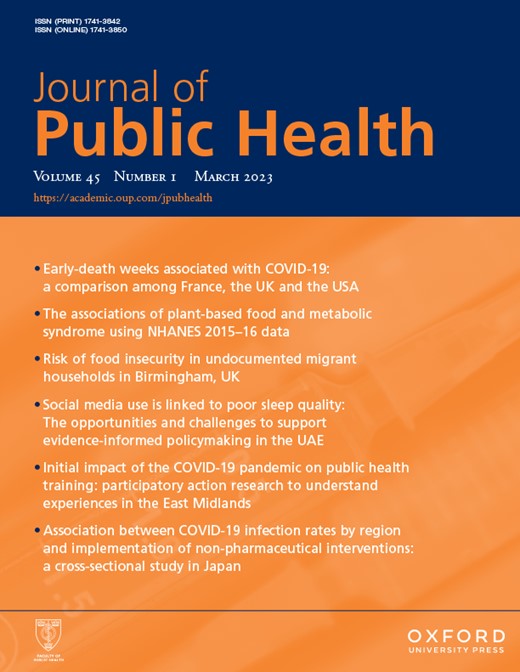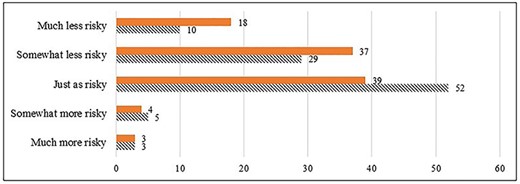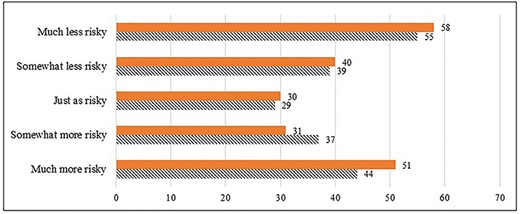-
PDF
- Split View
-
Views
-
Cite
Cite
W Kip Viscusi, The perceived risks of e-cigarettes to others and during pregnancy, Journal of Public Health, Volume 45, Issue 1, March 2023, Pages 202–205, https://doi.org/10.1093/pubmed/fdab352
Close - Share Icon Share
Abstract
Public Health England has concluded that e-cigarettes are much safer than cigarettes for the user and for secondhand exposures, but it has not reached a definitive conclusion regarding pregnancy risks. How people perceive the risks to others is less well understood.
This study uses an online UK sample of 1041 adults to examine perceived e-cigarette risks to others and during pregnancy. The survey examines relative risk beliefs of e-cigarettes compared to cigarettes and the percentage reduction in harm provided by e-cigarettes.
A majority of the sample believes that secondhand exposure to e-cigarette vapors poses less risk than secondhand smoke from cigarettes, but almost two-fifths of the sample equate the secondhand risks from e-cigarettes to those from cigarettes. There is somewhat greater perception of e-cigarette risks during pregnancy compared to beliefs regarding secondhand risks of vaping. About two-fifths of the population believe that e-cigarettes are less risky than cigarettes during pregnancy. Respondents believe that e-cigarettes reduce the harm to others by 39% and the harm to babies by 36%.
There is a general sense that e-cigarettes pose less risk than cigarettes, but there is a need for further risk communication regarding comparative e-cigarette risks.
Introduction
E-cigarettes are a product that potentially poses lower risks than conventional cigarettes. Although there is a substantial literature on beliefs regarding risks to the e-cigarette user, there is less evidence regarding perceived risks to others or to babies when used during pregnancy. Public Health England has taken an international leadership role in communicating its assessment that e-cigarettes are at least 95% safer for the user.1–3 The vapors from e-cigarettes also do not pose significant risks to others.2 However, the Public Health England review of the risks to babies did not find evidence to bolster similar claims regarding risks during pregnancy.3 Given the prominence of Public Health England’s risk communication efforts, it is instructive to examine how the UK public perceives the risks of secondhand vapors and risks for pregnant women. This article reports evidence for a sample of UK respondents in which there is substantial, but inadequate, public belief that secondhand vapors pose lower risks to others than cigarette smoke and a possible overestimation of the risk reduction when used during pregnancy.
Methods
The sample that is the focus of this paper consists of 1041 adult respondents who were surveyed in 2020 using the Qualtrics UK panel. Two-fifths of the sample had tried e-cigarettes, and 43% of the sample indicated awareness of Public Health England’s statements on e-cigarettes. For both risks of exposure and pregnancy risks, the survey included a relative risk belief question as well as a quantitative assessment of the extent of the harm that would be reduced by e-cigarettes compared to cigarettes. The secondhand risk exposure question was: ‘Smoking e-cigarettes also may expose others to vapors. How would you compare the risks of being exposed to e-cigarette vapors to the risks of being exposed to regular cigarette smoke? Much less risky than conventional cigarettes, somewhat less risky than conventional cigarettes, just as risky as conventional cigarettes, somewhat more risky than conventional cigarettes, and much more risky than conventional cigarettes.’ The question for pregnancy risks had the same response categories and had a similar structure: ‘Pregnant women may consider smoking e-cigarettes. How would you compare the risks to babies if pregnant women smoked e-cigarettes as compared to conventional cigarettes?’
Although qualitative risk belief questions are instructive, they do not measure the extent of the harm reduction that people perceive and whether Public Health England’s 95% risk reduction estimate carries over to these risks. To address the perceived amount of harm reduction, the survey inquired: ‘What percentage reduction in harm to others is achieved by smoking e-cigarettes as compared to regular cigarettes? Please give a number between 0% (no reduction in harm) and 100% (total reduction in harm.’ The counterpart question for pregnancy risks offered the same response options, but the harm question was: ‘What percentage reduction in harm to babies is achieved by pregnant women smoking e-cigarettes as compared to regular cigarettes?’
Results
Relative risk beliefs
Figure 1 compares the responses for relative risks to others, which are indicated by the solid line, and pregnancy risks, which are indicated using the dashed line. The perceived risks of secondhand exposures to vapors imply that 55% of the population believe that they are less risky than cigarettes to some degree, and almost two-fifths of the population believe that they are equally risky. A very small percentage regard e-cigarettes as more dangerous.
Distribution of relative risks beliefs for risks to others and pregnancy risks.
The risk assessments for risks during pregnancy indicate slightly higher perceived risks than environmental vapor exposures, as just over half of all respondents view e-cigarettes as just as risky as cigarettes during pregnancy. However, 39% consider them to be less risky to some degree notwithstanding the absence of pronouncements by Public Health England indicating that there is greater safety during pregnancy. Except for the two more risky categories that include few respondents, the pregnancy risk belief pattern is significantly different than that for secondhand smoke perceptions: much less risky (P < 0.01), somewhat less risky (P < 0.01), just as risky (P < 0.01), somewhat more risky (P = 0.82) and much more risky (P = 0.87).
Harm reduction beliefs
Figure 2 indicates the mean perceived harm reduction using solid lines for harm to others and dashed lines for harm during pregnancy. The perceived harm reduction varies by qualitative risk belief category, but it is substantial for all groups in each case. For risks the others, the mean harm reduction was 39%, and the median was 35%. For those indicating familiarity with Public Health England statements there is a 43% mean reduction and a 40% median reduction compared to those who have not heard those statements, for which there is a 36% mean and 30% median reduction (P < 0.01 for differences in means). For pregnancy risks, the mean perceived harm reduction was 36%, with a median of 30%. Respondents indicating familiarity with Public Health England statements assessed a mean harm reduction of 39% and a median of 40%, whereas those who had not heard these statements had a mean harm reduction of 33% and a median harm reduction of 25%, where the mean perceived harm reduction is significantly greater for those who have heard the statements (P < 0.01).
Percentage harm reduction corresponding to relative risk belief categories for risks to others and pregnancy risks.
Discussion
Main finding of this study
There is a widespread, but not universal belief that e-cigarettes pose lower risks to others and when used during pregnancy. These results are borne out with qualitative risk belief questions as well as assessments of the extent of harm reduction, which have mean values from 36% to 39%.
What is already known on this topic
Survey evidence on perceived risks from e-cigarettes have focused on risks to the vaper.1–3 Studies regarding the risks considered here are based almost entirely on US surveys. The views regarding risk to others indicate belief that e-cigarettes are moderately harmful to others.4 Respondents often believe that e-cigarettes are just as harmful to the fetus, but a substantial group believes that they are equally harmful.5–9
What this study adds
Given the prominence of efforts by Public Health England to communicate the comparative risks of e-cigarettes, it is important to understand how risk communication regarding risks to the e-cigarette user has affected their other risk beliefs in the UK. As in the case of evidence regarding risks to the user, most people believe that they are less risky, but a substantial segment considers them to be equally risky. In addition to asking the more usual qualitative comparative risk belief questions, this study also assesses the extent of the perceived harm reduction, which is <95% harm reduction for e-cigarette users.
Limitations of this study
The knowledge of the comparative risks for e-cigarettes is still evolving, particularly for pregnancy risks. It is not feasible given the state of our knowledge to ascertain whether pregnancy risks of e-cigarettes are overestimated or underestimated. The adult sample analyzed here is not a random national sample.
Conclusions
Public Health England has concluded that e-cigarettes are at least 95% safer than tobacco-burning cigarettes. It has also found that exposure of others to vaping poses fewer risk than do cigarettes, but it has not reached any conclusions regarding harm during pregnancy. Much of the public believes that e-cigarettes are safer than cigarettes in terms of these risks to others, but many also believe that they are equivalently risky. The extent of the perceived harm reduction is 39% for risks to others and 36% for risks to babies. Those who view e-cigarettes as much less risky to others or during pregnancy consider the harm to be over 50% below the harm posed by cigarettes. Beliefs regarding harm reduction are surprisingly similar for the different categories of risk beliefs based on ordinal risk rankings. There remains a substantial lack of understanding of the extent of the risk reduction for these risks.
Acknowledgments
Rachel Dalafave provided excellent research assistance. All financial support for this study was provided by Vanderbilt University.
Conflict of interest
The author serves as a consultant on smoking-related matters to law firms representing British American Tobacco Co.
Data availability
Data are available upon request.
W. Kip Viscusi, University Distinguished Professor of Law, Economics and Management





